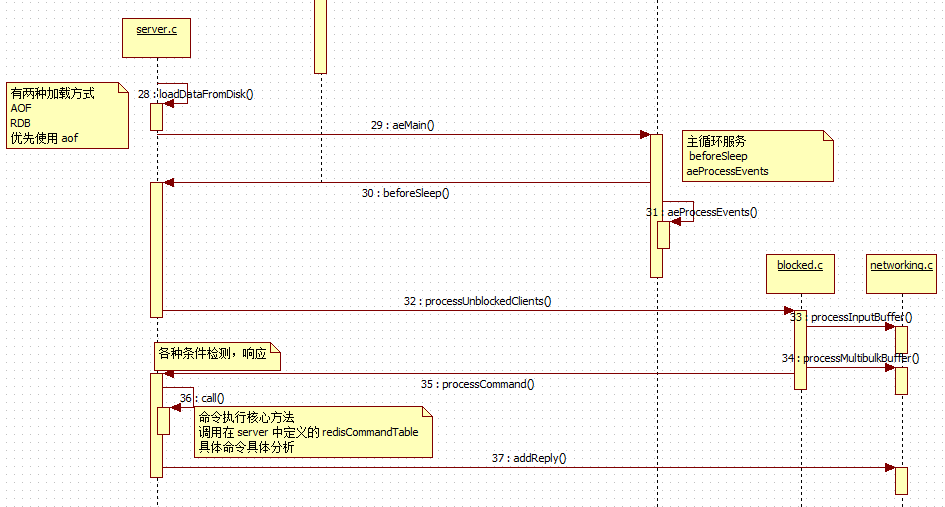redis是用c语言的写的缓存服务器,有高性能和多种数据类型支持的特性,广受互联网公司喜爱。
我们要分析其启动过程,首先就要先找到其入口。
当然我们应该是要先分析 Makefile 文件,然后找到最终编译成的文件,然后再顺势找到C语言入口 main(); 这里咱们就不费那事了,一是这事很枯燥,二是我也不知道找不找到得到。所以,就直接找到入口吧: 在 src/server.c 中,main() 函数就是了。
引用网上大牛的话归纳一下,main 函数执行的过程分以下几步:
1. Redis 会设置一些回调函数,当前时间,随机数的种子。回调函数实际上什么?举个例子,比如 Q/3 要给 Redis 发送一个关闭的命令,让它去做一些优雅的关闭,做一些扫尾清楚的工作,这个工作如果不设计回调函数,它其实什么都不会干。其实 C 语言的程序跑在操作系统之上,Linux 操作系统本身就是提供给我们事件机制的回调注册功能,所以它会设计这个回调函数,让你注册上,关闭的时候优雅的关闭,然后它在后面可以做一些业务逻辑。
2. 不管任何软件,肯定有一份配置文件需要配置。首先在服务器端会把它默认的一份配置做一个初始化。
3. Redis 在 3.0 版本正式发布之前其实已经有筛选这个模式了,但是这个模式,我很少在生产环境在用。Redis 可以初始化这个模式,比较复杂。
4. 解析启动的参数。其实不管什么软件,它在初始化的过程当中,配置都是由两部分组成的。第一部分,静态的配置文件;第二部分,动态启动的时候,main,就是参数给它的时候进去配置。
5. 把服务端的东西拿过来,装载 Config 配置文件,loadServerConfig。
6. 初始化服务器,initServer。
7. 从磁盘装载数据。
8. 有一个主循环程序开始干活,用来处理客户端的请求,并且把这个请求转到后端的业务逻辑,帮你完成命令执行,然后吐数据,这么一个过程。
我们以源码浏览形式,来看看具体实现。
main 函数入口:
注意 server 是一个全局变量,各函数进行操作时,都直接对其操作。
// struct redisServer server;// src/server.cint main(int argc, char **argv) {struct timeval tv;int j;// 测试环境变量设置#ifdef REDIS_TESTif (argc == 3 && !strcasecmp(argv[1], "test")) {if (!strcasecmp(argv[2], "ziplist")) {return (argc, argv);} else if (!strcasecmp(argv[2], "quicklist")) {quicklistTest(argc, argv);} else if (!strcasecmp(argv[2], "intset")) {return intsetTest(argc, argv);} else if (!strcasecmp(argv[2], "zipmap")) {return zipmapTest(argc, argv);} else if (!strcasecmp(argv[2], "sha1test")) {return sha1Test(argc, argv);} else if (!strcasecmp(argv[2], "util")) {return utilTest(argc, argv);} else if (!strcasecmp(argv[2], "sds")) {return sdsTest(argc, argv);} else if (!strcasecmp(argv[2], "endianconv")) {return endianconvTest(argc, argv);} else if (!strcasecmp(argv[2], "crc64")) {return crc64Test(argc, argv);}return -1; /* test not found */}#endif/* We need to initialize our libraries, and the server configuration. */#ifdef INIT_SETPROCTITLE_REPLACEMENTspt_init(argc, argv)ziplistTest;#endif// 设置些默认值, 随机数等等setlocale(LC_COLLATE,"");zmalloc_enable_thread_safeness();// oom 回调处理zmalloc_set_oom_handler(redisOutOfMemoryHandler);srand(time(NULL)^getpid());gettimeofday(&tv,NULL);dictSetHashFunctionSeed(tv.tv_sec^tv.tv_usec^getpid());server.sentinel_mode = checkForSentinelMode(argc,argv);// 初始化服务器默认配置, 将变化体现到 server 变量上initServerConfig();/* Store the executable path and arguments in a safe place in order* to be able to restart the server later. */server.executable = getAbsolutePath(argv[0]);server.exec_argv = zmalloc(sizeof(char*)*(argc+1));server.exec_argv[argc] = NULL;for (j = 0; j < argc; j++) server.exec_argv[j] = zstrdup(argv[j]);/* We need to init sentinel right now as parsing the configuration file* in sentinel mode will have the effect of populating the sentinel* data structures with master nodes to monitor. */if (server.sentinel_mode) {initSentinelConfig();initSentinel();}// 加载配置文件及其他命令/* Check if we need to start in redis-check-rdb mode. We just execute* the program main. However the program is part of the Redis executable* so that we can easily execute an RDB check on loading errors. */if (strstr(argv[0],"redis-check-rdb") != NULL)exit(redis_check_rdb_main(argv,argc));if (argc >= 2) {j = 1; /* First option to parse in argv[] */sds options = sdsempty();char *configfile = NULL;/* Handle special options --help and --version */if (strcmp(argv[1], "-v") == 0 ||strcmp(argv[1], "--version") == 0) version();if (strcmp(argv[1], "--help") == 0 ||strcmp(argv[1], "-h") == 0) usage();if (strcmp(argv[1], "--test-memory") == 0) {if (argc == 3) {memtest(atoi(argv[2]),50);exit(0);} else {fprintf(stderr,"Please specify the amount of memory to test in megabytes.\n");fprintf(stderr,"Example: ./redis-server --test-memory 4096\n\n");exit(1);}}/* First argument is the config file name? */if (argv[j][0] != '-' || argv[j][1] != '-') {configfile = argv[j];server.configfile = getAbsolutePath(configfile);/* Replace the config file in server.exec_argv with* its absoulte path. */zfree(server.exec_argv[j]);server.exec_argv[j] = zstrdup(server.configfile);j++;}/* All the other options are parsed and conceptually appended to the* configuration file. For instance --port 6380 will generate the* string "port 6380\n" to be parsed after the actual file name* is parsed, if any. */while(j != argc) {if (argv[j][0] == '-' && argv[j][1] == '-') {/* Option name */if (!strcmp(argv[j], "--check-rdb")) {/* Argument has no options, need to skip for parsing. */j++;continue;}if (sdslen(options)) options = sdscat(options,"\n");options = sdscat(options,argv[j]+2);options = sdscat(options," ");} else {/* Option argument */options = sdscatrepr(options,argv[j],strlen(argv[j]));options = sdscat(options," ");}j++;}if (server.sentinel_mode && configfile && *configfile == '-') {serverLog(LL_WARNING,"Sentinel config from STDIN not allowed.");serverLog(LL_WARNING,"Sentinel needs config file on disk to save state. Exiting...");exit(1);}resetServerSaveParams();loadServerConfig(configfile,options);sdsfree(options);} else {serverLog(LL_WARNING, "Warning: no config file specified, using the default config. In order to specify a config file use %s /path/to/%s.conf", argv[0], server.sentinel_mode ? "sentinel" : "redis");}server.supervised = redisIsSupervised(server.supervised_mode);int background = server.daemonize && !server.supervised;if (background) daemonize();// 初始化服务器// 重点如: 绑定监听端口号,设置 acceptTcpHandler 回调函数initServer();if (background || server.pidfile) createPidFile();redisSetProcTitle(argv[0]);redisAsciiArt();checkTcpBacklogSettings();if (!server.sentinel_mode) {/* Things not needed when running in Sentinel mode. */serverLog(LL_WARNING,"Server started, Redis version " REDIS_VERSION);#ifdef __linux__linuxMemoryWarnings();#endif// 从磁盘装载数据进行恢复或者初始化loadDataFromDisk();if (server.cluster_enabled) {if (verifyClusterConfigWithData() == C_ERR) {serverLog(LL_WARNING,"You can't have keys in a DB different than DB 0 when in ""Cluster mode. Exiting.");exit(1);}}if (server.ipfd_count > 0)serverLog(LL_NOTICE,"The server is now ready to accept connections on port %d", server.port);if (server.sofd > 0)serverLog(LL_NOTICE,"The server is now ready to accept connections at %s", server.unixsocket);} else {sentinelIsRunning();}/* Warning the user about suspicious maxmemory setting. */if (server.maxmemory > 0 && server.maxmemory < 1024*1024) {serverLog(LL_WARNING,"WARNING: You specified a maxmemory value that is less than 1MB (current value is %llu bytes). Are you sure this is what you really want?", server.maxmemory);}// 主循环服务, 只有收到 stop 命令后,才会退出aeSetBeforeSleepProc(server.el,beforeSleep);aeMain(server.el);// 关闭服务aeDeleteEventLoop(server.el);return 0;}
如上,即是redis的整个main方法了,整个启动流程也算是一目了然了。大概流程也不出预料,环境设置、默认参数、配置文件加载、初始化服务、恢复数据、死循环。
配置参数什么的都不用瞅了,但是对于哨兵、集群什么的,又太深入了。咱们还是先蜻蜓点水下,主要看年初始化服务器的时候做了些啥事!
初始化服务器:
// src/server.c, 在main中调用void initServer(void) {int j;// 注册几个事件响应处理器,比如前台模式运行或者调试模式的处理signal(SIGHUP, SIG_IGN);signal(SIGPIPE, SIG_IGN);setupSignalHandlers();if (server.syslog_enabled) {openlog(server.syslog_ident, LOG_PID | LOG_NDELAY | LOG_NOWAIT,server.syslog_facility);}// 初始化客户端相关的参数,设置到 server 中server.pid = getpid();server.current_client = NULL;server.clients = listCreate();server.clients_to_close = listCreate();server.slaves = listCreate();server.monitors = listCreate();server.clients_pending_write = listCreate();server.slaveseldb = -1; /* Force to emit the first SELECT command. */server.unblocked_clients = listCreate();server.ready_keys = listCreate();server.clients_waiting_acks = listCreate();server.get_ack_from_slaves = 0;server.clients_paused = 0;server.system_memory_size = zmalloc_get_memory_size();// 全局共享对象, 比如 OK, 1-10000, ...// 性能优化, 避免对相同的对象反复创建createSharedObjects();adjustOpenFilesLimit();// 创建事件循环对象 (aeEventLoop), 在 ae.c 中实现server.el = aeCreateEventLoop(server.maxclients+CONFIG_FDSET_INCR);// 创建db对象,所有数据存储其中server.db = zmalloc(sizeof(redisDb)*server.dbnum);/* Open the TCP listening socket for the user commands. */// 打开服务端口监听if (server.port != 0 &&listenToPort(server.port,server.ipfd,&server.ipfd_count) == C_ERR)exit(1);/* Open the listening Unix domain socket. */if (server.unixsocket != NULL) {unlink(server.unixsocket); /* don't care if this fails */server.sofd = anetUnixServer(server.neterr,server.unixsocket,server.unixsocketperm, server.tcp_backlog);if (server.sofd == ANET_ERR) {serverLog(LL_WARNING, "Opening Unix socket: %s", server.neterr);exit(1);}anetNonBlock(NULL,server.sofd);}/* Abort if there are no listening sockets at all. */if (server.ipfd_count == 0 && server.sofd < 0) {serverLog(LL_WARNING, "Configured to not listen anywhere, exiting.");exit(1);}/* Create the Redis databases, and initialize other internal state. */// 初始化各db,实际就是由这么几个数组来动作db的for (j = 0; j < server.dbnum; j++) {server.db[j].dict = dictCreate(&dbDictType,NULL);server.db[j].expires = dictCreate(&keyptrDictType,NULL);server.db[j].blocking_keys = dictCreate(&keylistDictType,NULL);server.db[j].ready_keys = dictCreate(&objectKeyPointerValueDictType,NULL);server.db[j].watched_keys = dictCreate(&keylistDictType,NULL);server.db[j].eviction_pool = evictionPoolAlloc();server.db[j].id = j;server.db[j].avg_ttl = 0;}// pub/sub 参数初始化server.pubsub_channels = dictCreate(&keylistDictType,NULL);server.pubsub_patterns = listCreate();listSetFreeMethod(server.pubsub_patterns,freePubsubPattern);listSetMatchMethod(server.pubsub_patterns,listMatchPubsubPattern);server.cronloops = 0;// rdb,aof 参数初始化server.rdb_child_pid = -1;server.aof_child_pid = -1;server.rdb_child_type = RDB_CHILD_TYPE_NONE;aofRewriteBufferReset();server.aof_buf = sdsempty();server.lastsave = time(NULL); /* At startup we consider the DB saved. */server.lastbgsave_try = 0; /* At startup we never tried to BGSAVE. */server.rdb_save_time_last = -1;server.rdb_save_time_start = -1;server.dirty = 0;resetServerStats();/* A few stats we don't want to reset: server startup time, and peak mem. */server.stat_starttime = time(NULL);server.stat_peak_memory = 0;server.resident_set_size = 0;server.lastbgsave_status = C_OK;server.aof_last_write_status = C_OK;server.aof_last_write_errno = 0;server.repl_good_slaves_count = 0;updateCachedTime();/* Create out timers, that's our main way to process background* operations. */// 创建定时器,用于运行后台事务,每隔1s运行一次// 由 serverCron 承载任务,执行任务如 指标统计,操作日志持久化,db扩容,客户端管理...if (aeCreateTimeEvent(server.el, 1, serverCron, NULL, NULL) == AE_ERR) {serverPanic("Can't create event loop timers.");exit(1);}/* Create an event handler for accepting new connections in TCP and Unix* domain sockets. */// 创建socket文件监控, 由 acceptTcpHandler 承载处理for (j = 0; j < server.ipfd_count; j++) {if (aeCreateFileEvent(server.el, server.ipfd[j], AE_READABLE,acceptTcpHandler,NULL) == AE_ERR){serverPanic("Unrecoverable error creating server.ipfd file event.");}}if (server.sofd > 0 && aeCreateFileEvent(server.el,server.sofd,AE_READABLE,acceptUnixHandler,NULL) == AE_ERR) serverPanic("Unrecoverable error creating server.sofd file event.");// 如果开启了AOF功能,就打开AOF文件/* Open the AOF file if needed. */if (server.aof_state == AOF_ON) {server.aof_fd = open(server.aof_filename,O_WRONLY|O_APPEND|O_CREAT,0644);if (server.aof_fd == -1) {serverLog(LL_WARNING, "Can't open the append-only file: %s",strerror(errno));exit(1);}}/* 32 bit instances are limited to 4GB of address space, so if there is* no explicit limit in the user provided configuration we set a limit* at 3 GB using maxmemory with 'noeviction' policy'. This avoids* useless crashes of the Redis instance for out of memory. */if (server.arch_bits == 32 && server.maxmemory == 0) {serverLog(LL_WARNING,"Warning: 32 bit instance detected but no memory limit set. Setting 3 GB maxmemory limit with 'noeviction' policy now.");server.maxmemory = 3072LL*(1024*1024); /* 3 GB */server.maxmemory_policy = MAXMEMORY_NO_EVICTION;}if (server.cluster_enabled) clusterInit();replicationScriptCacheInit();// lua 脚本初始化scriptingInit(1);// 初始化慢查询日志变量slowlogInit();// 延迟监控初始化,仅创建变量latencyMonitorInit();// 初始化几个系统必须的线程(线程池),执行任务,while死循环bioInit();}
通过以上,我们可以清楚明白,在初始化服务器时,高大上的C都干了啥。总体来说就是: 设置系统回调、开启端口监听、开启socket监听、开启后台任务、开启AOF、脚本初始化、线程池初始化。。。(做这些事是容易的,难的是设计之初如何架构其功能)
下面我们来看几个初始服务器时的关键函数方法。
1. aeEventLoop 的创建
aeEventLoop 是后续进行任务处理的重要数据结构。
// ae.c, 创建 aeEventLoop 对象,封装底层的 事件模式,统一对外服务aeEventLoop *aeCreateEventLoop(int setsize) {aeEventLoop *eventLoop;int i;if ((eventLoop = zmalloc(sizeof(*eventLoop))) == NULL) goto err;eventLoop->events = zmalloc(sizeof(aeFileEvent)*setsize);eventLoop->fired = zmalloc(sizeof(aeFiredEvent)*setsize);if (eventLoop->events == NULL || eventLoop->fired == NULL) goto err;eventLoop->setsize = setsize;eventLoop->lastTime = time(NULL);eventLoop->timeEventHead = NULL;eventLoop->timeEventNextId = 0;eventLoop->stop = 0;eventLoop->maxfd = -1;eventLoop->beforesleep = NULL;// 根据系统不同,选择不同的实现,C里面的多态自然是用 #ifdef 来实现了if (aeApiCreate(eventLoop) == -1) goto err;/* Events with mask == AE_NONE are not set. So let's initialize the* vector with it. */for (i = 0; i < setsize; i++)eventLoop->events[i].mask = AE_NONE;return eventLoop;err:if (eventLoop) {zfree(eventLoop->events);zfree(eventLoop->fired);zfree(eventLoop);}return NULL;}// 选择不同的io模型, 优先级: evport > epoll > kqueue > select#ifdef HAVE_EVPORT#include "ae_evport.c"#else#ifdef HAVE_EPOLL#include "ae_epoll.c"#else#ifdef HAVE_KQUEUE#include "ae_kqueue.c"#else#include "ae_select.c"#endif#endif#endif// epoll 实现static int aeApiCreate(aeEventLoop *eventLoop) {aeApiState *state = zmalloc(sizeof(aeApiState));if (!state) return -1;state->events = zmalloc(sizeof(struct epoll_event)*eventLoop->setsize);if (!state->events) {zfree(state);return -1;}state->epfd = epoll_create(1024); /* 1024 is just a hint for the kernel */if (state->epfd == -1) {zfree(state->events);zfree(state);return -1;}eventLoop->apidata = state;return 0;}// ae_epoll.c, linux 创建epoll句柄static int aeApiCreate(aeEventLoop *eventLoop) {aeApiState *state = zmalloc(sizeof(aeApiState));if (!state) return -1;state->events = zmalloc(sizeof(struct epoll_event)*eventLoop->setsize);if (!state->events) {zfree(state);return -1;}state->epfd = epoll_create(1024); /* 1024 is just a hint for the kernel */if (state->epfd == -1) {zfree(state->events);zfree(state);return -1;}eventLoop->apidata = state;return 0;}
2. acceptTcpHandler, 对于网络请求的接入处理
// networking.c, acceptTcpHandlervoid acceptTcpHandler(aeEventLoop *el, int fd, void *privdata, int mask) {int cport, cfd, max = MAX_ACCEPTS_PER_CALL;char cip[NET_IP_STR_LEN];UNUSED(el);UNUSED(mask);UNUSED(privdata);while(max--) {// 获取fd, ip, portcfd = anetTcpAccept(server.neterr, fd, cip, sizeof(cip), &cport);if (cfd == ANET_ERR) {if (errno != EWOULDBLOCK)serverLog(LL_WARNING,"Accepting client connection: %s", server.neterr);return;}serverLog(LL_VERBOSE,"Accepted %s:%d", cip, cport);// 创建客户端对象,加入到 server.clients 中acceptCommonHandler(cfd,0,cip);}}// anet.c, 解析 ip, port, fdint anetTcpAccept(char *err, int s, char *ip, size_t ip_len, int *port) {int fd;struct sockaddr_storage sa;socklen_t salen = sizeof(sa);if ((fd = anetGenericAccept(err,s,(struct sockaddr*)&sa,&salen)) == -1)return ANET_ERR;if (sa.ss_family == AF_INET) {struct sockaddr_in *s = (struct sockaddr_in *)&sa;if (ip) inet_ntop(AF_INET,(void*)&(s->sin_addr),ip,ip_len);if (port) *port = ntohs(s->sin_port);} else {struct sockaddr_in6 *s = (struct sockaddr_in6 *)&sa;if (ip) inet_ntop(AF_INET6,(void*)&(s->sin6_addr),ip,ip_len);if (port) *port = ntohs(s->sin6_port);}return fd;}// anet.c, 调用系统函数获取 socket 数据static int anetGenericAccept(char *err, int s, struct sockaddr *sa, socklen_t *len) {int fd;while(1) {fd = accept(s,sa,len);if (fd == -1) {if (errno == EINTR)continue;else {anetSetError(err, "accept: %s", strerror(errno));return ANET_ERR;}}break;}return fd;}
3. bioInit 线程创建
// bio.c/* Initialize the background system, spawning the thread. */void bioInit(void) {pthread_attr_t attr;pthread_t thread;size_t stacksize;int j;/* Initialization of state vars and objects */for (j = 0; j < BIO_NUM_OPS; j++) {pthread_mutex_init(&bio_mutex[j],NULL);pthread_cond_init(&bio_newjob_cond[j],NULL);pthread_cond_init(&bio_step_cond[j],NULL);bio_jobs[j] = listCreate();bio_pending[j] = 0;}/* Set the stack size as by default it may be small in some system */pthread_attr_init(&attr);pthread_attr_getstacksize(&attr,&stacksize);if (!stacksize) stacksize = 1; /* The world is full of Solaris Fixes */while (stacksize < REDIS_THREAD_STACK_SIZE) stacksize *= 2;pthread_attr_setstacksize(&attr, stacksize);/* Ready to spawn our threads. We use the single argument the thread* function accepts in order to pass the job ID the thread is* responsible of. */for (j = 0; j < BIO_NUM_OPS; j++) {void *arg = (void*)(unsigned long) j;// bioProcessBackgroundJobs 用于执行线程任务if (pthread_create(&thread,&attr,bioProcessBackgroundJobs,arg) != 0) {serverLog(LL_WARNING,"Fatal: Can't initialize Background Jobs.");exit(1);}bio_threads[j] = thread;}}
二、主循环服务
接下来我们看看另一个重要的流程,主循环服务。redis作为一个存储服务,必定需要一直运行等待,这就是while死循环的应用了。在前面各种环境初始化完成后,进入while循环服务。
// src/ae.c 主循环服务void aeMain(aeEventLoop *eventLoop) {eventLoop->stop = 0;// eventLoop 会被 acceptTcpHandler 进行数据填充// 此处 beforesleep 为外部初始化的// aeSetBeforeSleepProc(), 设置 beforeSleepwhile (!eventLoop->stop) {if (eventLoop->beforesleep != NULL)eventLoop->beforesleep(eventLoop);// 由 aeProcessEvents 处理事件aeProcessEvents(eventLoop, AE_ALL_EVENTS);}}
很简单,就做两件事: beforesleep, aeProcessEvents, 看起来 aeProcessEvents() 是个核对服务。我们可以先观察其行为。
1. aeProcessEvents, 处理各种事件(数据准备)
// ae.c/* Process every pending time event, then every pending file event* (that may be registered by time event callbacks just processed).* Without special flags the function sleeps until some file event* fires, or when the next time event occurs (if any).** If flags is 0, the function does nothing and returns.* if flags has AE_ALL_EVENTS set, all the kind of events are processed.* if flags has AE_FILE_EVENTS set, file events are processed.* if flags has AE_TIME_EVENTS set, time events are processed.* if flags has AE_DONT_WAIT set the function returns ASAP until all* the events that's possible to process without to wait are processed.** The function returns the number of events processed. */int aeProcessEvents(aeEventLoop *eventLoop, int flags){int processed = 0, numevents;/* Nothing to do? return ASAP */if (!(flags & AE_TIME_EVENTS) && !(flags & AE_FILE_EVENTS)) return 0;/* Note that we want call select() even if there are no* file events to process as long as we want to process time* events, in order to sleep until the next time event is ready* to fire. */if (eventLoop->maxfd != -1 ||((flags & AE_TIME_EVENTS) && !(flags & AE_DONT_WAIT))) {int j;aeTimeEvent *shortest = NULL;struct timeval tv, *tvp;// 获取最近 timer事件, 用于判定是否有需要执行至少一个时间事件if (flags & AE_TIME_EVENTS && !(flags & AE_DONT_WAIT))shortest = aeSearchNearestTimer(eventLoop);if (shortest) {long now_sec, now_ms;/* Calculate the time missing for the nearest* timer to fire. */aeGetTime(&now_sec, &now_ms);tvp = &tv;tvp->tv_sec = shortest->when_sec - now_sec;if (shortest->when_ms < now_ms) {tvp->tv_usec = ((shortest->when_ms+1000) - now_ms)*1000;tvp->tv_sec --;} else {tvp->tv_usec = (shortest->when_ms - now_ms)*1000;}if (tvp->tv_sec < 0) tvp->tv_sec = 0;if (tvp->tv_usec < 0) tvp->tv_usec = 0;} else {/* If we have to check for events but need to return* ASAP because of AE_DONT_WAIT we need to set the timeout* to zero */if (flags & AE_DONT_WAIT) {tv.tv_sec = tv.tv_usec = 0;tvp = &tv;} else {/* Otherwise we can block */tvp = NULL; /* wait forever */}}// 获取等待事件numevents = aeApiPoll(eventLoop, tvp);for (j = 0; j < numevents; j++) {aeFileEvent *fe = &eventLoop->events[eventLoop->fired[j].fd];int mask = eventLoop->fired[j].mask;int fd = eventLoop->fired[j].fd;int rfired = 0;/* note the fe->mask & mask & ... code: maybe an already processed* event removed an element that fired and we still didn't* processed, so we check if the event is still valid. */// 此处将会调用前面设置好的 acceptTcpHandler 服务if (fe->mask & mask & AE_READABLE) {rfired = 1;fe->rfileProc(eventLoop,fd,fe->clientData,mask);}if (fe->mask & mask & AE_WRITABLE) {if (!rfired || fe->wfileProc != fe->rfileProc)fe->wfileProc(eventLoop,fd,fe->clientData,mask);}processed++;}}// 时间事件处理, serverCron 调用/* Check time events */if (flags & AE_TIME_EVENTS)processed += processTimeEvents(eventLoop);return processed; /* return the number of processed file/time events */}// ae_epoll.c, 调用系统底层, 获取网络就绪事件, 放入 eventLoop->fired 中static int aeApiPoll(aeEventLoop *eventLoop, struct timeval *tvp) {aeApiState *state = eventLoop->apidata;int retval, numevents = 0;retval = epoll_wait(state->epfd,state->events,eventLoop->setsize,tvp ? (tvp->tv_sec*1000 + tvp->tv_usec/1000) : -1);if (retval > 0) {int j;numevents = retval;for (j = 0; j < numevents; j++) {int mask = 0;struct epoll_event *e = state->events+j;// 将系统事件类型转换为 redis 的事件类型if (e->events & EPOLLIN) mask |= AE_READABLE;if (e->events & EPOLLOUT) mask |= AE_WRITABLE;if (e->events & EPOLLERR) mask |= AE_WRITABLE;if (e->events & EPOLLHUP) mask |= AE_WRITABLE;eventLoop->fired[j].fd = e->data.fd;eventLoop->fired[j].mask = mask;}}return numevents;}
2. 主循环服务之 beforeSleep
beforeSleep是在进入 aeMain之前,直接绑定在 el 上的。是在主循环中进行检测的条件,但其承担了重要的作用,比如客户请求的命令解析和处理!
// server.c, beforeSleep/* This function gets called every time Redis is entering the* main loop of the event driven library, that is, before to sleep* for ready file descriptors. */void beforeSleep(struct aeEventLoop *eventLoop) {UNUSED(eventLoop);/* Call the Redis Cluster before sleep function. Note that this function* may change the state of Redis Cluster (from ok to fail or vice versa),* so it's a good idea to call it before serving the unblocked clients* later in this function. */if (server.cluster_enabled) clusterBeforeSleep();/* Run a fast expire cycle (the called function will return* ASAP if a fast cycle is not needed). */if (server.active_expire_enabled && server.masterhost == NULL)activeExpireCycle(ACTIVE_EXPIRE_CYCLE_FAST);/* Send all the slaves an ACK request if at least one client blocked* during the previous event loop iteration. */if (server.get_ack_from_slaves) {robj *argv[3];argv[0] = createStringObject("REPLCONF",8);argv[1] = createStringObject("GETACK",6);argv[2] = createStringObject("*",1); /* Not used argument. */replicationFeedSlaves(server.slaves, server.slaveseldb, argv, 3);decrRefCount(argv[0]);decrRefCount(argv[1]);decrRefCount(argv[2]);server.get_ack_from_slaves = 0;}/* Unblock all the clients blocked for synchronous replication* in WAIT. */if (listLength(server.clients_waiting_acks))processClientsWaitingReplicas();/* Try to process pending commands for clients that were just unblocked. */// 处理可用的客户端请求if (listLength(server.unblocked_clients))processUnblockedClients();// AOF刷盘服务/* Write the AOF buffer on disk */flushAppendOnlyFile(0);// 将一些被挂起的数据写入客户端socket中/* Handle writes with pending output buffers. */handleClientsWithPendingWrites();}// blocking.c, 处理被解阻塞的客户端连接, 顺便处理客户端请求/* This function is called in the beforeSleep() function of the event loop* in order to process the pending input buffer of clients that were* unblocked after a blocking operation. */void processUnblockedClients(void) {listNode *ln;client *c;while (listLength(server.unblocked_clients)) {ln = listFirst(server.unblocked_clients);serverAssert(ln != NULL);c = ln->value;listDelNode(server.unblocked_clients,ln);c->flags &= ~CLIENT_UNBLOCKED;/* Process remaining data in the input buffer, unless the client* is blocked again. Actually processInputBuffer() checks that the* client is not blocked before to proceed, but things may change and* the code is conceptually more correct this way. */if (!(c->flags & CLIENT_BLOCKED)) {if (c->querybuf && sdslen(c->querybuf) > 0) {processInputBuffer(c);}}}}// networking.c, 处理接收到的数据, 调起下游处理服务void processInputBuffer(client *c) {server.current_client = c;/* Keep processing while there is something in the input buffer */while(sdslen(c->querybuf)) {/* Return if clients are paused. */if (!(c->flags & CLIENT_SLAVE) && clientsArePaused()) break;/* Immediately abort if the client is in the middle of something. */if (c->flags & CLIENT_BLOCKED) break;/* CLIENT_CLOSE_AFTER_REPLY closes the connection once the reply is* written to the client. Make sure to not let the reply grow after* this flag has been set (i.e. don't process more commands). */if (c->flags & CLIENT_CLOSE_AFTER_REPLY) break;/* Determine request type when unknown. */// 根据第一个字符是否是 *, 分为两种类型协议, 处理方式不同if (!c->reqtype) {if (c->querybuf[0] == '*') {c->reqtype = PROTO_REQ_MULTIBULK;} else {c->reqtype = PROTO_REQ_INLINE;}}if (c->reqtype == PROTO_REQ_INLINE) {if (processInlineBuffer(c) != C_OK) break;} else if (c->reqtype == PROTO_REQ_MULTIBULK) {if (processMultibulkBuffer(c) != C_OK) break;} else {serverPanic("Unknown request type");}/* Multibulk processing could see a <= 0 length. */if (c->argc == 0) {resetClient(c);} else {/* Only reset the client when the command was executed. */// 经过前面请求解析后,进入请求处理核心流程if (processCommand(c) == C_OK)resetClient(c);}}server.current_client = NULL;}// server.c, 根据网络模块解析好的客户端命令,进行相应的业务处理/* If this function gets called we already read a whole* command, arguments are in the client argv/argc fields.* processCommand() execute the command or prepare the* server for a bulk read from the client.** If C_OK is returned the client is still alive and valid and* other operations can be performed by the caller. Otherwise* if C_ERR is returned the client was destroyed (i.e. after QUIT). */int processCommand(client *c) {/* The QUIT command is handled separately. Normal command procs will* go through checking for replication and QUIT will cause trouble* when FORCE_REPLICATION is enabled and would be implemented in* a regular command proc. */if (!strcasecmp(c->argv[0]->ptr,"quit")) {addReply(c,shared.ok);c->flags |= CLIENT_CLOSE_AFTER_REPLY;return C_ERR;}/* Now lookup the command and check ASAP about trivial error conditions* such as wrong arity, bad command name and so forth. */// 根据第一个参数 查找处理命令,在 server.c 的顶部有定义: redisCommandTablec->cmd = c->lastcmd = lookupCommand(c->argv[0]->ptr);if (!c->cmd) {flagTransaction(c);addReplyErrorFormat(c,"unknown command '%s'",(char*)c->argv[0]->ptr);return C_OK;} else if ((c->cmd->arity > 0 && c->cmd->arity != c->argc) ||(c->argc < -c->cmd->arity)) {flagTransaction(c);addReplyErrorFormat(c,"wrong number of arguments for '%s' command",c->cmd->name);return C_OK;}// 以下是一系列判断,是否符合命令执行前提/* Check if the user is authenticated */if (server.requirepass && !c->authenticated && c->cmd->proc != authCommand){flagTransaction(c);addReply(c,shared.noautherr);return C_OK;}/* If cluster is enabled perform the cluster redirection here.* However we don't perform the redirection if:* 1) The sender of this command is our master.* 2) The command has no key arguments. */if (server.cluster_enabled &&!(c->flags & CLIENT_MASTER) &&!(c->flags & CLIENT_LUA &&server.lua_caller->flags & CLIENT_MASTER) &&!(c->cmd->getkeys_proc == NULL && c->cmd->firstkey == 0)){int hashslot;if (server.cluster->state != CLUSTER_OK) {flagTransaction(c);clusterRedirectClient(c,NULL,0,CLUSTER_REDIR_DOWN_STATE);return C_OK;} else {int error_code;clusterNode *n = getNodeByQuery(c,c->cmd,c->argv,c->argc,&hashslot,&error_code);if (n == NULL || n != server.cluster->myself) {flagTransaction(c);clusterRedirectClient(c,n,hashslot,error_code);return C_OK;}}}/* Handle the maxmemory directive.** First we try to free some memory if possible (if there are volatile* keys in the dataset). If there are not the only thing we can do* is returning an error. */if (server.maxmemory) {int retval = freeMemoryIfNeeded();/* freeMemoryIfNeeded may flush slave output buffers. This may result* into a slave, that may be the active client, to be freed. */if (server.current_client == NULL) return C_ERR;/* It was impossible to free enough memory, and the command the client* is trying to execute is denied during OOM conditions? Error. */if ((c->cmd->flags & CMD_DENYOOM) && retval == C_ERR) {flagTransaction(c);addReply(c, shared.oomerr);return C_OK;}}/* Don't accept write commands if there are problems persisting on disk* and if this is a master instance. */if (((server.stop_writes_on_bgsave_err &&server.saveparamslen > 0 &&server.lastbgsave_status == C_ERR) ||server.aof_last_write_status == C_ERR) &&server.masterhost == NULL &&(c->cmd->flags & CMD_WRITE ||c->cmd->proc == pingCommand)){flagTransaction(c);if (server.aof_last_write_status == C_OK)addReply(c, shared.bgsaveerr);elseaddReplySds(c,sdscatprintf(sdsempty(),"-MISCONF Errors writing to the AOF file: %s\r\n",strerror(server.aof_last_write_errno)));return C_OK;}/* Don't accept write commands if there are not enough good slaves and* user configured the min-slaves-to-write option. */if (server.masterhost == NULL &&server.repl_min_slaves_to_write &&server.repl_min_slaves_max_lag &&c->cmd->flags & CMD_WRITE &&server.repl_good_slaves_count < server.repl_min_slaves_to_write){flagTransaction(c);addReply(c, shared.noreplicaserr);return C_OK;}/* Don't accept write commands if this is a read only slave. But* accept write commands if this is our master. */if (server.masterhost && server.repl_slave_ro &&!(c->flags & CLIENT_MASTER) &&c->cmd->flags & CMD_WRITE){addReply(c, shared.roslaveerr);return C_OK;}/* Only allow SUBSCRIBE and UNSUBSCRIBE in the context of Pub/Sub */if (c->flags & CLIENT_PUBSUB &&c->cmd->proc != pingCommand &&c->cmd->proc != subscribeCommand &&c->cmd->proc != unsubscribeCommand &&c->cmd->proc != psubscribeCommand &&c->cmd->proc != punsubscribeCommand) {addReplyError(c,"only (P)SUBSCRIBE / (P)UNSUBSCRIBE / PING / QUIT allowed in this context");return C_OK;}/* Only allow INFO and SLAVEOF when slave-serve-stale-data is no and* we are a slave with a broken link with master. */if (server.masterhost && server.repl_state != REPL_STATE_CONNECTED &&server.repl_serve_stale_data == 0 &&!(c->cmd->flags & CMD_STALE)){flagTransaction(c);addReply(c, shared.masterdownerr);return C_OK;}/* Loading DB? Return an error if the command has not the* CMD_LOADING flag. */if (server.loading && !(c->cmd->flags & CMD_LOADING)) {addReply(c, shared.loadingerr);return C_OK;}/* Lua script too slow? Only allow a limited number of commands. */if (server.lua_timedout &&c->cmd->proc != authCommand &&c->cmd->proc != replconfCommand &&!(c->cmd->proc == shutdownCommand &&c->argc == 2 &&tolower(((char*)c->argv[1]->ptr)[0]) == 'n') &&!(c->cmd->proc == scriptCommand &&c->argc == 2 &&tolower(((char*)c->argv[1]->ptr)[0]) == 'k')){flagTransaction(c);addReply(c, shared.slowscripterr);return C_OK;}/* Exec the command */if (c->flags & CLIENT_MULTI &&c->cmd->proc != execCommand && c->cmd->proc != discardCommand &&c->cmd->proc != multiCommand && c->cmd->proc != watchCommand){queueMultiCommand(c);addReply(c,shared.queued);} else {// 由 call 函数执行各自的 commandcall(c,CMD_CALL_FULL);c->woff = server.master_repl_offset;if (listLength(server.ready_keys))handleClientsBlockedOnLists();}return C_OK;}
到此,整个redis的启动及简要的请求处理流程就完成了。
下面以两个UML来重新审视整个流程。
1. redisServer 初始化时序图

2. 主循环服务时序图

总体来说,就单个命令的执行流程来说,简单到 就是一个 命令表的查找,到数据处理响应。

腾讯、阿里、滴滴后台面试题汇总总结 — (含答案)
面试:史上最全多线程面试题 !
最新阿里内推Java后端面试题
JVM难学?那是因为你没认真看完这篇文章

关注作者微信公众号 —《JAVA烂猪皮》
了解更多java后端架构知识以及最新面试宝典



看完本文记得给作者点赞+在看哦~~~大家的支持,是作者源源不断出文的动力
作者:等你归去来
出处:https://www.cnblogs.com/yougewe/p/12187858.html





